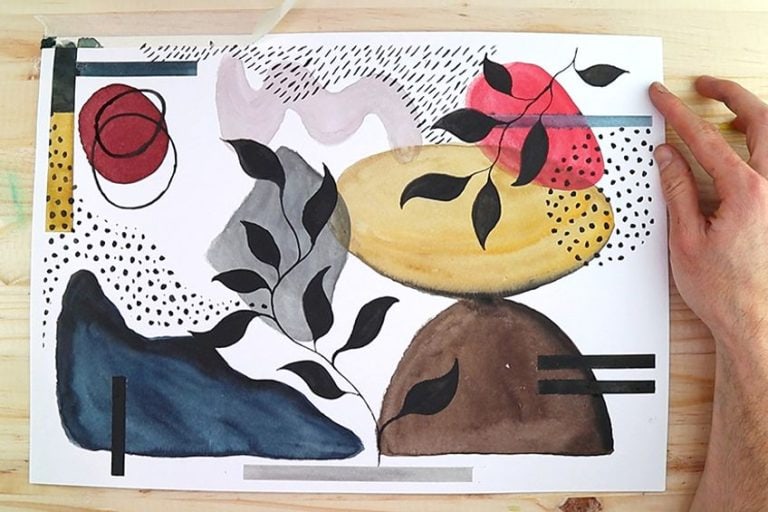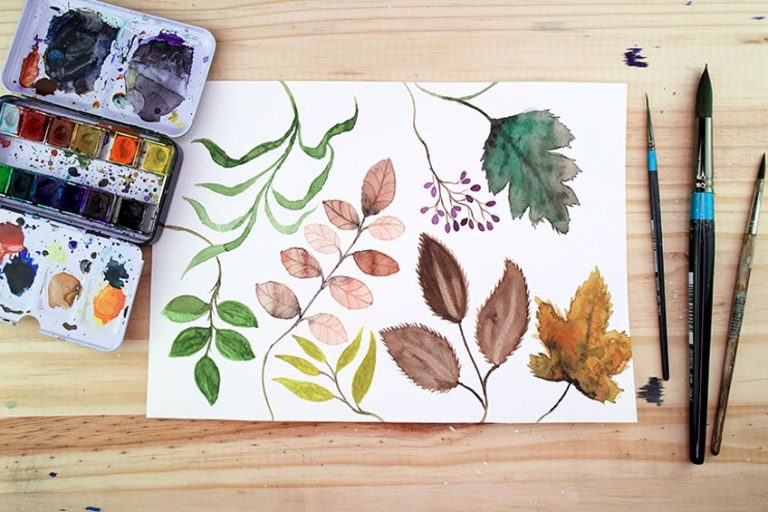Acrylic Paint on Fabric – Your Guide for Acrylic Painting on Clothes
This post may contain affiliate links. We may earn a small commission from purchases made through them, at no additional cost to you.
Can acrylic paint be used on fabric? There might be no need to go out and buy paint, as you may already have some lying around you can use. Those acrylic paints you might have can be used on fabric. Before you begin with your project, we have a few tips to help you out.
Table of Contents
- 1 Can you use Acrylic Paint on Fabric?
- 2 What is meant by the Term Fabric Medium?
- 3 Here are some excellent Tips for using Acrylic Paint on Fabric
- 4 Acrylic Paint on Fabric without Medium
- 5 Directions on how to Paint on Fabric
- 6 Should you Heat set Acrylic on Fabric?
- 7 Aftercare for Acrylic Painting on Clothes
- 8 Frequently Asked Questions
Can you use Acrylic Paint on Fabric?
If you know how to do it, then painting on fabric is fairly easy. Before you begin, first mix the acrylic paint with either GAC 900 Fabric Medium or Liquitex Fabric Medium.
Do not be disappointed with the results, after your fabric painting project is complete. As long as you follow the above advice, it should work out great. Remember, fabric painting depends largely on the special blend of the acrylic paints you are using.

What is meant by the Term Fabric Medium?
This simply means altering Acrylic paints into Fabric Paints. Fabric Medium is an acrylic polymer liquid blend, that has no pigments, which you can mix with your acrylic paints to give your painted fabric a beautiful soft feel. The fabric can easily be hand or machine washed when the paint is dry. Once the fabric medium has been mixed with your acrylic paint it will improve the use and also the flow of your paint when applied to the fabric.
The Benefits of using a Fabric Medium:
- When your paint is thinned with water, the Fabric Medium helps to control colors from bleeding.
- It can also produce watercolor effects when painting onto your fabric and assists the paint in penetrating and adhering to the fabric better. This will allow the artists a lot more versatility when painting on fabrics.
- The Fabric Medium provides an opportunity for a greater variety of colors. Also, you can use various other painting techniques over and above brushing and painting.
- Many artists, after thinning their paints with a little water, add fabric medium and use it to airbrush their fabrics. As your textile paints do not offer a large option or variety of colors, by using fabric medium you will have an unlimited option of colors for your acrylic paints.

Acrylic Paint against Acrylic mixed with Medium on Fabric
The most important result of adding medium, is that after your fabric has dried, the paint remains fairly flexible. When you use acrylic paint on fabric without medium, your fabric becomes fairly stiff with a rough texture. The medium also creates a more durable paint, which help prevent any peeling and cracks form developing.
If you are at all unsure if you should use fabric medium, you need to consider if you need your project to be more flexible or long-lasting. Therefore, the purpose of your project is important, will you be using it on clothes where flexibility is essential, or are you going to cover a piece of furniture where durability is a vital factor.
So, we can conclude that using acrylic paint on fabric without medium, is excellent for things like decorative tapestries or other art pieces. These objects are for display purposes only and are not exposed to wear and tear.
Here are some excellent Tips for using Acrylic Paint on Fabric
- You will need to adjust your paint consistency by adding a fabric medium. If you desire a soft and stretchable result you will have to use Liquitex Fabric Medium then if necessary add some distilled water to thin your paint, but be careful not to make it too thin.
- First, use a separate piece of material to test your paint mixture, as each type of fabric has a different absorbency and will influence the way the paint is applied.
- To prevent your fabric from adhering to your work surface, you need to lay down a protective sheet. If you are painting on a t-shirt, you need to insert a piece of cardboard inside to obtain the best results.
- Types of fabric that are suitable for fabric painting. Flannel, cotton-poly blends, suede, knitted, leather, cotton, corduroy, woven, most synthetics, terry cloth, velvet, felt, velveteen, and silk.
- Remember, before you paint on your fabric, you need to wash it to remove any starches or co-polymers that have been applied. Then it needs to dry properly.
- There are also fabric markers for fabric, based on acrylic paint.

Acrylic Paint on Fabric without Medium
Can acrylic paint be used on fabric? The tips below will help you with using acrylic paint on fabric without medium. Follow these tips to create better adhesion to the fabric, as well as improve the flexibility of your painted fabric.
- Before you start your project, take a piece of medium-grit sandpaper, and very lightly rub the surface of your fabric. This will cause the paint to adhere much better to the fabric.
- By using a spray bottle filled with water, lightly spray the whole surface of your fabric. The wet paint applied to the wet fabric allows the paint to adhere with a more even coating.
- Before you begin, use a little water to thin out your paint. This helps you to apply the paint more evenly.
Directions on how to Paint on Fabric
- Silk or cotton that have a fairly tight weave will give you the best colors.
- Where you have hard edges on your fabric, apply a wax resist or any waxy substance. After you have finished you can easily remove the wax by dry cleaning your fabric.
- Soft edges on your fabric, use some diluted Flow-Aid Additive and wet that section.
- If your paint is too thick mix it with some gel medium.
- When using Heavy Body Acrylic, take an ordinary cake decorator tip and screw it onto your tube. Test different nozzle thicknesses and see how you can create various distinct lines.
Watercolor Effects when for Acrylic on Fabric
- If you want the paint to disperse evenly and quickly, make use of a Lightweight fabric.
- If you allow your paint to dry, you will be able to apply multiple layers of paint without the colors underneath coming through.
- When using Soft Body, you need to use some distilled water to thin your paint to the desired thickness.
Should you Heat set Acrylic on Fabric?
When you have completed fabric painting, you might want to go even further, and heat set it. By doing this you make sure that it lasts much longer, as well as prevents damage. If you have followed all the directions for using acrylic paint on fabric, your painted project is basically completed.
Besides from adding fabric medium, you have the choice of heat setting it, which can be done using an iron. This option has been used a lot in the past and has always worked out perfectly. Here are the basic steps for you to follow:
Step 1: Waiting
If you have painted onto a fabric that requires washing, you need to heat set it after you have finished painting. The process is the same when you iron a garment to remove any creases, only this time you need to iron it for longer.
We do not advise ironing your project soon after you finish painting it. You should wait for at least 24 hours; this ensures that your paint has dried properly. After you have finished heat setting your fabric, wait for at least 4 to 5 days before you wash it.
Step 2: Heat set your Acrylic Painting on Clothes
When ironing your fabric, do not make use of the steam settings on your iron. The paint requires only dry heat for it to set. If your iron automatically switches to steam settings, turn them off and make sure your water container is empty.
If possible, try to not iron on the fabric painted side but the opposite side. If this is not possible, all you need to do is take a piece of clean fabric and place it over the painted section of your garment or fabric. Doing either of these options will ensure you do not burn the fabric painted side of your garment or cause the paint to melt onto your iron.
Also, it is advisable to place a clean piece of fabric on top of your ironing board. This will help to protect your ironing board cover from paint colors when you iron your fabric and the painted side is facing down.
- Depending on what type of fabric, set your iron on medium to hot.
- Keep moving the iron around over the painted area for a couple of minutes, which will prevent it from burning your fabric.
If you have painted on a more delicate fabric, you need to set your iron on a lower heat and keep on ironing for a longer time.

Step 3: How long do you need to Iron for?
To be sure the paint on your fabric has set properly, you need to iron for 3 to 5 minutes and no less. You must use the medium to hot setting on your iron, and make sure you iron on the wrong side of your fabric.
Be careful not to touch your fabric at this time, as it will be quite hot. We also suggest you iron smaller sections at a time, this enables you to move around quicker so the paint won’t get too hot or too cold.
Aftercare for Acrylic Painting on Clothes
Proper care of your garment or fabric is important and not too difficult. Remember, if you have used your acrylic paint without a medium, it will not be very stable when cleaning. So, take extra care with your fabric in this case.
We recommend, if possible, you hand wash your fabric and allow it to drip dry. If you need to machine wash, we suggest you use a gentle cycle and use a low heat setting on your tumble dryer. This will ensure that the life of your fabric and your design will last longer.
Follow these tips to make your fabric last longer:
- If you make use of a washing machine or tumble dryer, select a gentle press wash and low heat setting.
- Hand-wash the fabric if possible and allow to drip dry.
- Do not use hot water to soak your fabric in.
- Wait for at least 4 days before you wash your fabric, this ensures the paint has dried properly.
- If you use a dry-cleaning machine, make sure that it spin-dries at room temperature. You can dry clean suede.
- If the garment or fabric needs to be ironed later, always use a low setting on your iron and make sure you iron it on the reverse side.
- Try to avoid spot cleaning.
Can you use acrylic paint on fabric? Hopefully, all the above information has answered this question. Remember, if you want your garment lasting longer, try to wash it less frequently, as the washing tends to degrade the paint. This causes the paint to lose its adhesion as the fabric fibers expand and shrink with repeated washing.
View our Acrylic Paint on Fabric web story here.
Frequently Asked Questions
Can You Use Acrylic Paint on Fabric Without a Medium?
You can use acrylic paint on fabric without a medium. Although, it will make the fabric extremely stiff, which might be counterproductive if you intend on wearing the fabric. Using a medium preserves the flexibility of your fabric and reduces absorption.
Can You Use Acrylic Paint on Fabric?
You can use acrylic paint on fabric. When using acrylic paint on fabric but it is always best to use a medium on the fabric before your paint is applied. Failing to use a medium on your fabric can cause the fabric to become stiff, which isn’t ideal if you intend on wearing your workpiece once it has been painted.
How Do You Seal Acrylic Paint on Fabric?
Once the paint has been applied to the fabric and dried completely, you can seal it by heat pressing it. How do you heat press acrylic paint on fabric? All that you need to do is place it in heat press or give it a once-over with a hot iron. Ensure that your paint has been allowed to dry for 24 hours beforehand though.
How Do You Keep Acrylic Paint on Fabric?
The best way to ensure that acrylic paint stays on fabric is to heat seal it. Heat sealing ensures that the fabric and paint are fused to one another and will not run when washed or worn. Acrylic paint can be sealed into fabric by applying heat, either by use of a clothing iron or heat press.
Does Acrylic Paint Stay on Fabric?
Yes, acrylic paint does stay on fabric as long as the fabric has been primed with a medium and sealed. A medium allows the fabric to retain its flexibility, and the use of heat to seal your fabric workpiece will ensure that the paint does not run or flake off.
Can Acrylic Paint Be Used on Fabric and Washed?
Acrylic paint can be applied to fabric and washed. The best way to ensure that your acrylic fabric art does not run once it is washed is to ensure that a medium is applied to the fabric before the paint is applied. Additional measures to prevent damage or removal during washing is to heat seal your fabric.
In 2005, Charlene completed her wellness degrees in therapeutic aromatherapy and reflexology at the International School of Reflexology and Meridian Therapy. She worked for a company offering corporate wellness programs for several years before opening her own therapy practice. In 2015, she was asked by a digital marketer friend to join her company as a content creator, and it was here that she discovered her enthusiasm for writing. Since entering the world of content creation, she has gained a lot of experience over the years writing about various topics such as beauty, health, wellness, travel, crafting, and much more. Due to various circumstances, she had to give up her therapy practice and now works as a freelance writer. Since she is a very creative person and as a balance to writing likes to be active in various areas of art and crafts, the activity at acrylgiessen.com is perfect for her to contribute their knowledge and experience in various creative topics.
Learn more about Charlene Lewis and about us.







